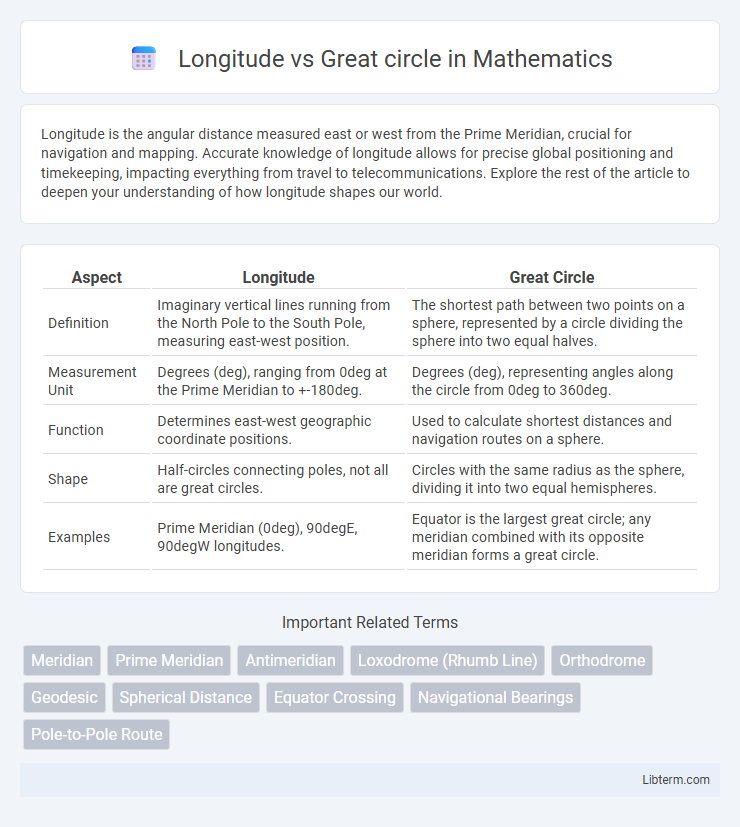Longitude is the angular distance measured east or west from the Prime Meridian, crucial for navigation and mapping. Accurate knowledge of longitude allows for precise global positioning and timekeeping, impacting everything from travel to telecommunications. Explore the rest of the article to deepen your understanding of how longitude shapes our world.
Table of Comparison
| Aspect | Longitude | Great Circle |
|---|---|---|
| Definition | Imaginary vertical lines running from the North Pole to the South Pole, measuring east-west position. | The shortest path between two points on a sphere, represented by a circle dividing the sphere into two equal halves. |
| Measurement Unit | Degrees (deg), ranging from 0deg at the Prime Meridian to +-180deg. | Degrees (deg), representing angles along the circle from 0deg to 360deg. |
| Function | Determines east-west geographic coordinate positions. | Used to calculate shortest distances and navigation routes on a sphere. |
| Shape | Half-circles connecting poles, not all are great circles. | Circles with the same radius as the sphere, dividing it into two equal hemispheres. |
| Examples | Prime Meridian (0deg), 90degE, 90degW longitudes. | Equator is the largest great circle; any meridian combined with its opposite meridian forms a great circle. |
Introduction to Longitude and Great Circle
Longitude measures angular distance east or west of the Prime Meridian, essential for global navigation and mapping. Great circles represent the shortest path between two points on a sphere, crucial for calculating efficient routes on Earth's surface. Understanding the relationship between longitude and great circle navigation enables accurate positioning and optimized travel paths.
Defining Longitude: Key Concepts
Longitude measures the angular distance east or west of the Prime Meridian, expressed in degrees from 0deg to 180deg. It is a key coordinate in the geographic coordinate system used to pinpoint locations on Earth's surface. Understanding longitude is essential for navigation, timekeeping, and accurately plotting great circle routes, which represent the shortest path between two points on a sphere.
What is a Great Circle?
A Great Circle is the largest possible circle that can be drawn on a sphere, representing the shortest path between two points on the Earth's surface. Unlike lines of longitude, which run from pole to pole, Great Circles can be any circle whose center coincides with the Earth's center, including the Equator. This concept is essential for navigation and aviation, as Great Circle routes minimize travel distance and fuel consumption across long distances.
Historical Background of Longitude and Great Circles
The concept of longitude originated in ancient navigation practices, with significant advancements during the 18th century when John Harrison developed the marine chronometer, enabling accurate timekeeping crucial for determining longitude at sea. Great circles, fundamental in spherical geometry, were studied by ancient Greek mathematicians like Hipparchus and later applied in navigation to plot the shortest path between two points on the globe, revolutionizing maritime routes. The historical development of longitude and great circle concepts transformed global exploration, enhancing mapping accuracy and navigational efficiency.
Mathematical Differences: Longitude vs Great Circle
Longitude lines are semicircles running from the North Pole to the South Pole, defined by a fixed angular measurement east or west of the Prime Meridian. Great circles are the largest possible circles on a sphere, representing the shortest path between two points, and always lie in a plane passing through the Earth's center. Mathematically, longitude lines represent constant longitudinal angles, whereas great circles result from the intersection of the sphere with any plane through its center, making their path calculation reliant on spherical trigonometry.
Role in Navigation and Mapping
Longitude lines, also known as meridians, are essential for pinpointing exact locations on Earth's surface by measuring degrees east or west of the Prime Meridian, playing a crucial role in navigation and global mapping systems. Great circle routes represent the shortest path between two points on a sphere, enabling efficient route planning for air and sea navigation, reducing travel distance and fuel consumption. Combining longitude references with great circle calculations ensures precise and optimized navigation, critical for modern GPS technology and cartography.
Practical Applications in Modern Geography
Longitude lines are essential for determining precise locations and time zones across the globe, enabling GPS technology to provide accurate navigation for aviation, maritime travel, and logistics. Great circle routes represent the shortest distance between two points on Earth's surface, optimizing flight paths and reducing fuel consumption in commercial aviation. Combining longitude coordinates with great circle calculations enhances route planning efficiency, contributing to cost-effective and environmentally sustainable transportation solutions in modern geography.
Advantages and Limitations of Each Method
Longitude-based navigation offers straightforward calculations by measuring angular distance east or west from the Prime Meridian, facilitating easy mapping and time zone determination, but it lacks accuracy over long distances due to Earth's curvature. Great circle routes provide the shortest path between two points on a sphere, minimizing fuel consumption and travel time in aviation and maritime navigation; however, their complex calculations require advanced spherical trigonometry and are less intuitive for everyday use. Both methods serve critical roles in geospatial analysis, with longitude useful for simpler locational referencing and great circle essential for optimizing long-distance travel efficiency.
Comparison Table: Longitude vs Great Circle
Longitude lines are geographic coordinates that run from the North Pole to the South Pole, used to measure east-west positions on Earth. Great circles represent the shortest path between two points on a sphere, crucial for navigation and aviation routes. While longitude lines are fixed meridians, great circles vary depending on the starting and ending points, offering optimized travel distances across the globe.
Conclusion: Choosing the Right Approach
Selecting the appropriate approach between longitude-based navigation and great circle routes depends on the specific application and desired accuracy. Great circle paths offer the shortest distance between two points on the Earth's surface, making them ideal for long-haul aviation and maritime travel. Longitude-based navigation remains practical for simpler, localized routes and less complex mapping tasks where precision over vast distances is less critical.
Longitude Infographic

 libterm.com
libterm.com